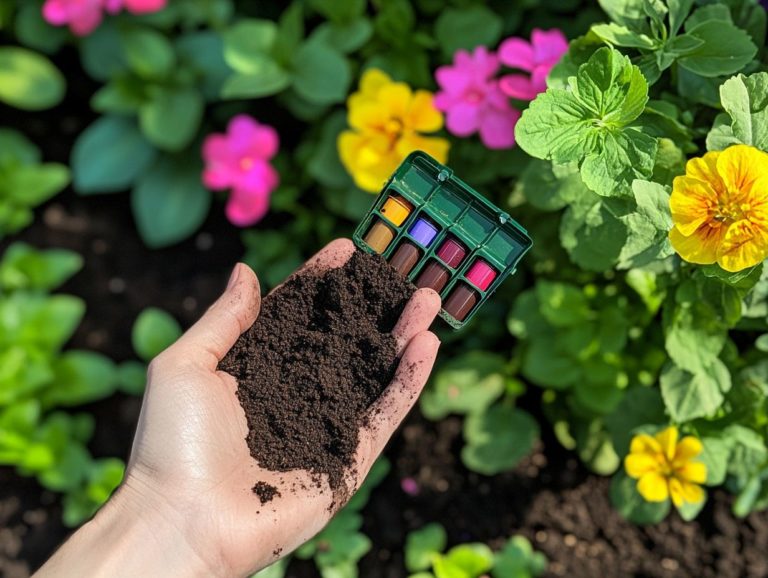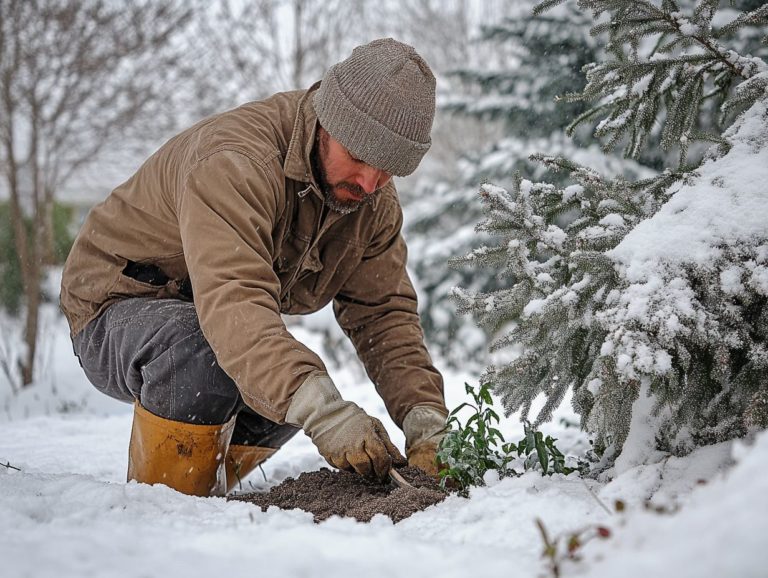How to Amend Clay Soil for Cold-Climate Gardening
For many gardeners, clay soil is a challenge, especially in colder climates. Proper drainage and strong root growth are vital for healthy plants.
This guide explores the unique characteristics and challenges of clay soil, highlighting the importance of amending it for successful gardening.
You will discover various methods for improving clay, ranging from organic to inorganic solutions, along with practical tips for effectively incorporating these amendments into your gardening routine.
With the right techniques and materials, you can quickly transform that stubborn clay soil into a thriving garden!
Contents
- Key Takeaways:
- Understanding Clay Soil
- Why Amend Clay Soil?
- Methods for Amending Clay Soil
- Choosing the Right Amendments
- How to Incorporate Amendments into Clay Soil
- Maintaining Healthy Soil
- Frequently Asked Questions
- 1. How can I improve clay soil for gardening in a cold climate?
- 2. When is the best time to amend clay soil for cold-climate gardening?
- 3. Can I use sand to amend clay soil for cold-climate gardening?
- 4. Will adding gypsum help amend clay soil for cold-climate gardening?
- 5. How often should I amend clay soil for cold-climate gardening?
- 6. Can I plant directly into amended clay soil for cold-climate gardening?
Key Takeaways:

- Amending clay soil is essential for successful gardening in cold climates. Organic amendments are preferred and should be incorporated during the fall for the best results.
- Choosing the right amendments, such as compost, peat moss, and perlite, can greatly improve the structure and drainage of clay soil. Regular maintenance and adding organic matter help sustain healthy soil for long-term gardening success.
- Understanding the characteristics and challenges of clay soil is crucial for determining the best methods for amending it. Benefits include improved water retention, aeration, and nutrient availability for plants to thrive in cold climates.
Understanding Clay Soil
Understanding clay soil is crucial for anyone aiming to cultivate a thriving garden, as it has unique characteristics that significantly influence plant growth.
This dense and heavy soil can cause drainage issues and compaction problems, which hinder root growth and compromise overall soil health.
Rich in iron oxide, clay soil has distinct colors and properties that are essential to recognize. By understanding these factors, you can make informed choices to enhance your garden soil, ensuring a vibrant ecosystem for various plants.
Characteristics and Challenges
Clay soil has a dense texture, leading to significant drainage issues and compaction that directly impact moisture levels and plant growth.
These characteristics create a challenging environment for roots, as compacted layers restrict their ability to absorb essential nutrients and water. While clay retains moisture well, excess wetness can lead to waterlogged conditions that suffocate roots and promote rot. This imbalance stunts root growth and heightens the risk of disease and plant stress.
To tackle this challenge, gardeners should take proactive steps to enhance soil structure. Incorporating organic matter is key to optimizing moisture management and boosting plant health in clay-rich areas.
Why Amend Clay Soil?
Amending clay soil is essential for improving its structure and promoting overall soil health, which fosters better plant nutrition and root growth. By adding high-quality amendments like organic matter, you can significantly enhance the soil’s drainage and aeration. For specific strategies on how to build healthy soil in cold climates, effectively addressing the challenges of heavy clay.
This thoughtful process creates a more favorable environment for various plants, ensuring optimal growth and productivity in your garden beds.
Benefits of Improving Clay Soil
Improving clay soil provides numerous benefits, including enhanced soil health and increased plant growth, along with better drainage all contributing to a flourishing garden ecosystem.
By transforming heavy clay into a more manageable texture, you can effectively address issues like waterlogging and poor aeration. Amending your soil with organic matter, such as compost or well-rotted manure, elevates nutrient availability and encourages beneficial microorganisms that support robust root development.
This results in improved moisture retention, ensuring your plants have access to water during dry spells while preventing excess saturation that can suffocate their roots. Ultimately, these improvements create a vibrant garden where your plants thrive, exhibit stronger pest resistance, and produce a bountiful display of blooms or fruits, leading to a healthier landscape overall.
Start amending your clay soil today for a better garden tomorrow!
Methods for Amending Clay Soil

You can choose from various methods to amend clay soil. Each method enhances soil structure and fertility based on your gardening needs, including understanding soil needs for cold-climate plants.
It s essential to grasp the differences between organic and inorganic amendments. Both can effectively address the challenges of heavy clay conditions. Techniques like incorporating soil conditioners and utilizing cover crops markedly improve soil quality, fostering better drainage and aeration for your garden.
Organic vs. Inorganic Amendments
Understanding the debate between organic and inorganic amendments is key. Each offers unique advantages for enhancing soil structure and fertility.
Organic amendments boost water retention and aeration. They also help tiny organisms that support plant growth. These natural materials release nutrients slowly, minimizing leaching and promoting long-term health.
In contrast, inorganic amendments such as chemical fertilizers and lime quickly address specific nutrient deficiencies. They are perfect for situations where immediate results are essential.
Blend organic and inorganic amendments for a balanced soil. This mix boosts productivity and keeps your gardening sustainable.
Timing and Techniques
Timing and techniques are essential for effectively amending clay soil. For those gardening in colder climates, understanding the importance of soil testing can significantly enhance the benefits of your soil amendments through specific seasonal practices.
To choose the right time for applying these amendments, consider the seasons and your local climate. Typically, spring and fall are the prime times. During these periods, soil temperatures favor microbial activity, accelerating the breakdown of organic materials.
Incorporating amendments just before you plant maximizes moisture retention. This allows the soil to robustly support new growth. Techniques like mixing compost or gypsum into the soil improve drainage and elevate nutrient availability. Your plants will thrive, whether it s a wet or dry spell.
Choosing the Right Amendments
Selecting the appropriate amendments for clay soil is crucial for enhancing its health and structure, which ultimately creates optimal conditions for plant growth. For specific guidance, consider exploring how to manage soil pH in cold-climate gardening.
You have many options, from organic materials like compost and aged manure to inorganic choices that provide rapid nutrient enhancements.
By assessing the specific needs of your garden soil, you can make informed decisions about the most effective amendments. This will elevate soil quality and promote thriving plants.
Commonly Used Materials
Common materials for amending clay soil include compost, gypsum, and perlite. Each offers distinct advantages for enhancing both soil structure and fertility.
These materials transform dense clay into a nurturing environment for your plants. Compost enriches the soil with vital nutrients, fostering microbial activity and improving moisture retention.
Gypsum is effective at breaking up compacted soil, promoting better drainage and allowing roots to penetrate more easily. Meanwhile, perlite aerates the soil, preventing it from becoming overly saturated while ensuring that roots have adequate access to air.
Together, these amendments create a well-balanced ecosystem. This supports healthier plant growth and encourages robust yields, leading to vibrant gardens.
How to Incorporate Amendments into Clay Soil

Incorporating amendments into clay soil demands a systematic approach to ensure you achieve the desired results. This ultimately enhances soil quality and promotes plant health. A step-by-step guide will serve you well as you effectively integrate various amendments.
Focus on techniques such as aerating the soil, layering amendments, and ensuring proper mixing to create healthy soil. By adhering to these gardening strategies, you can successfully navigate the common challenges posed by heavy clay and improve your gardening experience.
Step-by-Step Guide
A step-by-step guide to incorporating amendments into clay soil will help you transform heavy clay into a more fertile and productive gardening medium, including improving soil structure for cold-weather gardens.
To effectively achieve this transformation, begin by aerating the soil to improve air circulation and drainage. You can do this using a garden fork or specialized aeration tools.
Once you ve aerated, consider implementing layering techniques by spreading organic matter, such as compost or well-rotted manure, evenly over the surface. It’s crucial to mix these amendments thoroughly into the soil to ensure that essential nutrients penetrate deeply.
Regularly evaluating the soil’s moisture and the level of acidity or alkalinity in the soil will further enhance its health, paving the way for a thriving garden ecosystem.
Maintaining Healthy Soil
Healthy soil is your garden s best friend! It s crucial for long-term success, as it guarantees that your plants receive the vital nutrients and environment they need for optimal growth.
By incorporating organic compost and utilizing effective mulching techniques, you can enhance soil health and prevent issues like compaction problems and drainage issues.
Seasonal planting and quality amendments are essential for preserving soil quality. This fosters a thriving garden ecosystem that flourishes throughout the year.
Tips for Long-Term Success
Let s dive into some fantastic tips for growing great plants! Implementing strategies for long-term success in maintaining healthy soil will elevate your gardening experience and foster exceptional plant growth over time.
To cultivate a thriving garden, it s essential to grasp the role of organic matter think compost and well-rotted manure in enriching the soil. This enrichment improves soil structure and enhances its ability to retain nutrients.
Adopting effective mulching techniques, such as using straw, wood chips, or shredded leaves, serves multiple purposes: it suppresses weeds, retains moisture, and gradually breaks down to nourish the soil.
Creating a welcoming environment for beneficial insects, like ladybugs and pollinators, is also crucial. These friendly visitors help balance the garden ecosystem, ensuring your soil remains vibrant and productive.
Incorporating each of these practices into your gardening routine contributes to a sustainable strategy that nurtures both your plants and the environment.
Frequently Asked Questions
1. How can I improve clay soil for gardening in a cold climate?

To amend clay soil for cold-climate gardening, you can add organic matter such as aged compost, manure, or shredded leaves. For a comprehensive approach, check out this guide on how to amend soil for cold climates. This will help improve drainage and provide nutrients for your plants.
2. When is the best time to amend clay soil for cold-climate gardening?
The best time to amend clay soil for cold-climate gardening is in the fall, just before the ground freezes. This timing allows for soil amendments effective for cold climates to break down and enhance the soil structure before spring planting.
3. Can I use sand to amend clay soil for cold-climate gardening?
No, using sand to amend clay soil is not recommended. Mixing sand with clay creates a dense, hard soil that makes it tough for plant roots to grow. Instead, use organic matter to improve soil quality and consider compost tea for added nutrients.
4. Will adding gypsum help amend clay soil for cold-climate gardening?
Yes, adding gypsum can improve clay soil for preparing your soil for spring in cold climates. Gypsum breaks up clay particles and enhances drainage, which helps plants thrive.
5. How often should I amend clay soil for cold-climate gardening?
Amending clay soil every year is a smart choice for a thriving garden. This practice maintains improved soil structure and provides essential nutrients for your plants, especially when using the top 10 soil amendments for cold-weather gardens.
6. Can I plant directly into amended clay soil for cold-climate gardening?
Yes, you can plant directly into amended clay soil. Just ensure you mix amendments thoroughly to avoid pockets of unamended soil. Adding a layer of mulch helps retain moisture and prevents soil compaction. Consider using perlite, a lightweight material that improves drainage and aeration.






